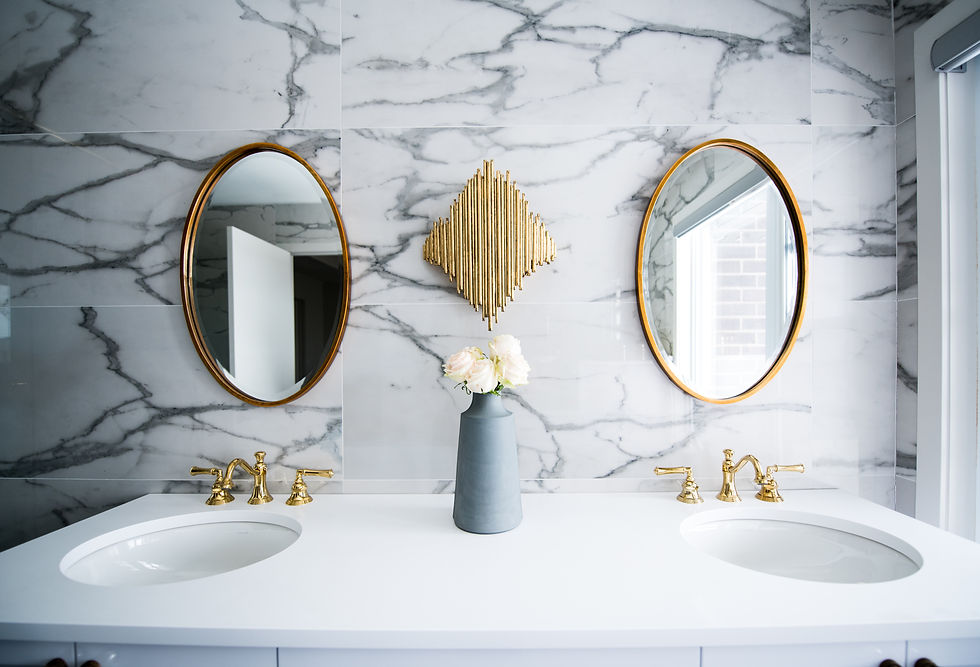The Importance of Symmetry in Interior Design
- Aishah Coleman

- Nov 6, 2023
- 3 min read

In interior design, every element plays a pivotal role in shaping a space's overall
ambiance and aesthetics. One aspect that holds particular significance and can significantly influence the perception of harmony and balance is symmetry.
Symmetry is a design principle that involves creating a sense of equilibrium by arranging elements to reflect a mirror image or a balanced composition. Whether it's a contemporary living room, a cozy bedroom, or a superb hall, incorporating symmetry can transform an ordinary space into a visually captivating and emotionally pleasing environment.
The Art of Visual Balance:
Humans have an innate appreciation for balance and proportion. Symmetry creates a feeling of stability and order, which resonates with our sense of visual harmony. When a room lacks symmetry, it can feel disjointed and chaotic, making it difficult for occupants to relax and feel comfortable. On the other hand, a well-executed balance brings a sense of calm and tranquility, creating a space that is inviting and conducive to relaxation.
Creating a Focal Point:

Symmetry can be instrumental in establishing a focal point in a room. A focal point is an area that draws the eye and serves as the center of attention. By using symmetry to frame a focal point, such as a fireplace, a piece of art, or a large window, designers can emphasize the importance of that particular feature and create a sense of significance in the overall design.
A Sense of Elegance and Sophistication:

Symmetry has long been associated with elegance and sophistication. From classical architecture to luxurious palaces, symmetrical designs have been used to evoke a sense of opulence and grandeur. Even in modern and minimalist interiors, symmetry can add a touch of refinement and elevate the overall aesthetic appeal.
Balancing Asymmetry:

While symmetry is often celebrated, there is also a place for asymmetry in interior design. The key lies in striking the right balance between symmetry and asymmetry. Incorporating asymmetrical elements can add a touch of creativity and visual interest to a space, preventing it from feeling too rigid or monotonous. However, asymmetry is best used sparingly so as not to overwhelm the design and disrupt the sense of balance.
Symmetry in Different Design Styles:
Symmetry can be applied across various design styles, adapting to each one's unique characteristics. In traditional or classical designs, symmetrical layouts dominate, as seen in perfectly aligned furniture, matched patterns, and balanced proportions. In contrast, contemporary designs may incorporate asymmetry with subtle nods to symmetry for a modern, edgy look.
The Role of Furniture and Accessories:

Furniture placement plays a crucial role in achieving symmetry. Placing identical or similar pieces of furniture on either side of a room or around a focal point helps maintain visual balance. Similarly, pairing lamps, artwork, or accessories can enhance the symmetrical effect. Additionally, using mirrors to reflect a proportional space can amplify the sense of balance and create an illusion of a larger area.
Symmetry is a powerful tool that interior designers wield to create captivating spaces that resonate with our sense of balance and harmony. By harnessing the potential of symmetry, designers can elevate a room's aesthetics, establish focal points, and evoke emotions of elegance and sophistication.
While asymmetry has its place in design, the careful integration of symmetry and asymmetry can lead to spaces that are not only visually appealing but also emotionally uplifting and welcoming to all who inhabit them. So, the next time you embark on an interior design project, consider the power of symmetry and its ability to transform your space into a harmonious and beautiful sanctuary.




Comments